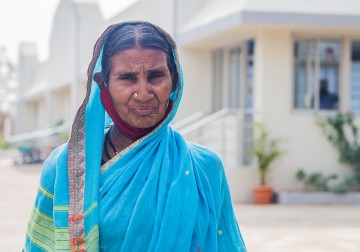In a new study from LVPEI, Drs. Harithaa Chadalavada, Srinivas Marmamula, and Rohit C. Khanna describe the age and gender distribution of patients with vision impairment and their access to eye care across the LVPEI network.
Women are more likely to have vision impairment (VI) than men. In fact, over half (55%) of the 1.1 billion people around the world with vision loss are women. Women have limited access to eye care, primarily because of cultural and socio-economic factors, leading to such disparities. Their travel is restricted, their financial freedoms are limited, and they lack social support to seek eye care. Women in low- and middle-income countries like India, especially in rural areas, are one of the most underserved groups when it comes to eye care access.
Primary and secondary eye care that is closer to their doorstep may improve women’s access to eye care. The L V Prasad Eye Institute (LVPEI) solution employs a five-tier pyramid model for eye care, where the bottom three layers aim to bring eye care closer to underserved groups, like women and the elderly, particularly in villages. Local vision centers (VCs) provide free eye examinations. Secondary centers (SCs) are headed by ophthalmologists who provide care for common ocular diseases, at no cost to those who cannot afford it. Together, these centers should address the twin issues of cost and access, leading to increased uptake in services. But is this model effective at promoting eye care access among women?
In a new study published in the Indian Journal of Ophthalmology, Drs. Harithaa P. Chadalavada, Srinivas Marmamula, and Rohit C. Khanna answer that question by assessing the age and gender distribution of patients with VI and their access to eye care across the LVPEI network in four Indian states: Andhra Pradesh, Telangana, Karnataka, and Odisha. The study included data of 7,31,307 patients from LVPEI’s electronic medical records in one year (2019). Nearly half of the patients (46.5%) visited LVPEI’s VCs, while 22% visited SCs. Most patients (86%) visited centers in Andhra Pradesh and Telangana. Nearly 65% of the people walking into a vision center did not have any vision impairment.
Most patients with VI who sought eye care were between 60-69 years of age, across the LVPEI pyramid. More women (51%) visited SCs than men, while only 43% visited the center of excellence in Hyderabad. Among patients with VI who visited either a VC or an SC, more than half (51.3%) were women, likely because such centers are closer to their home. Most patients visiting VCs had no VI, indicating the success of these centers in engendering a health seeking behavior in the population. Among the four states where LVPEI has a network, Odisha (with 11.1% of the patients in this study) recorded the widest gender gap in patients (42% female). This study shows that rural women are more likely to access eye care, especially if they have a vision impairment, if an eye care facility is close to their homes.
‘Having a pyramidal model has given us a unique opportunity to understand vision impairment, and the gender gap in health care across different levels of care,’ remarks Dr. Harithaa P. Chadalavada, consultant ophthalmologist at LVPEI, and the first author for this paper. ‘The uptake of our services is better when our presence is closer to the community, especially for women.’
Dr. Srinivas Marmamula, Network Associate Director of Public Health Research and Training at LVPEI concludes by saying, ‘Accessible and affordable eye care is essential to address needless vision loss. The LVPEI model is systematically achieving this. Reaching out to women and those in vulnerable age groups has been the hallmark of this remarkable model.’
Citation
Chadalavada HP, Marmamula S, Khanna RC. Vision impairment and access to eye care in an integrated network of eye care system in Southern and Eastern India. Indian J Ophthalmol. 2024;72(2):264-269
Photo credit: A patient at the Mudhole secondary centre; photo by Srinivas Marmamula



